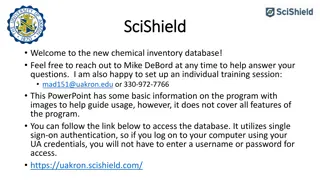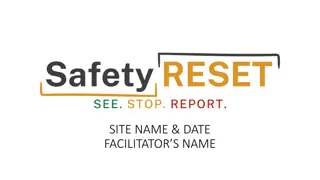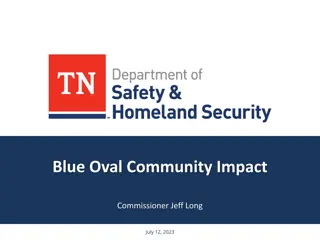Chemical Safety
Dr. Anu George emphasizes the importance of developing a chemical safety plan for handling hazardous substances. The plan includes components like hazard communication, proper labeling, MSDS availability, safe storage and disposal practices, employee training, incident reporting, and record-keeping. It also covers hazard communication methods such as verbal and visual communication, including GHS, NFPA, and HMIG classifications for hazardous chemicals.
Download Presentation
Please find below an Image/Link to download the presentation.
The content on the website is provided AS IS for your information and personal use only. It may not be sold, licensed, or shared on other websites without obtaining consent from the author. Download presentation by click this link. If you encounter any issues during the download, it is possible that the publisher has removed the file from their server.
Presentation Transcript
Chemical Safety Dr. Anu George
Developing a Chemical Safety Plan 1. 2. 3. Have a written Hazard Communication program for employees. Properly label hazardous chemical containers Have MSDS / SDS (Material Safety Data Sheets) on file for each hazardous chemical available Safe Storage of Chemicals Safe Disposal of Chemicals Using mitigating strategies such as chemical fume hoods, formalin monitoring devices Train employees about potential hazards. NCE / Incident/ Accident Reporting 4. 5. 6. 7. 8. Maintain records about the entire program. Important chapter in the Lab Safety Manual which has to be read and understood
1. HAZARD COMMUNICATION: Right to Know
Hazard Communications; Verbal MSDS LABELS GHS (Globally Harmonized System of classification and labeling of Chemicals) Hazard and Precautions phrases: Risk and Safety phrases: R and S Phrases. (are being phased out in favor of H and P Phrases of GHS) H and P Phrases
Hazard Communications; Visual Pictograms (GHS, EU Directive..) NFPA (National Fire Protection Association) Diamond HMIG (Hazardous Material Identification Guide) Color Bar.
Hazardous Chemicals Classification (GHS) Physical (H & P / R & S) Health (H & P / R & S) Environmental (H & P / R & S)
Hazard categorization: Health
NFPA Diamond (National Fire Protection Association)
HMIG Color Bar (Hazardous Material Identification Guide)
NEPA Diamond for Sodium Hypochlorite
Safety/ Precautionary Phrases, Pictograms
2. Labeling 1. 2. The identity or contents of the container. Appropriate hazard warnings, including words, pictures, symbols, or combinations that convey the health and/or physical hazards of the container s contents The name and address of the chemical manufacturer and the emergency telephone number. Containers that are too small to be labeled should be kept in a labeled larger container Any secondary container into which hazardous chemicals are transferred should be labeled fully Existing labels on containers carrying hazardous chemicals should not be removed or defaced Date of preparation and/or date placed in service and where appropriate, the date of expiration wherever warranted Unlabeled containers of chemicals should not be opened. 3. 4. 5. 6. 7. 8.
3. MSDS GHS Directives 1: Identification of the substance/mixture and of the company/undertaking 2: Hazards identification 3: Composition/information on ingredients 4: First aid measures 5: Firefighting measures 6: Accidental release measures 7: Handling and storage 8: Exposure controls/personal protection 9: Physical and chemical properties 10: Stability and reactivity 11: Toxicological information 12: Ecological information 13: Disposal considerations 14: Transport information 15: Regulatory information 16: Other information
4. Safe Storage of Chemicals Read storage instructions on MSDS of all your chemicals Minimize quantities kept in the lab. Bulk stocks should be kept in specially designated rooms or buildings. Chemicals should not be stored in alphabetical order. Keep glass containers off the floor, away from possible collisions with people and equipment Store chemicals away from sources of heat and direct sunlight Do not store hazardous liquids on shelves above eye level Place solvents requiring refrigeration in special flammable storage refrigerators and Store flammable liquids in flammable storage cabinets Never pour flammable liquids down the drain because they can cause an explosion.
Storage instructionsPlease Read Store .. In a dry place In a well ventilated place In a closed container Locked up In a corrosive resistant container Protected from sunlight At temperatures not exceeding . Do not expose to temperatures exceeding Away from other material
5. Safe Disposal Dispose of unwanted chemicals promptly Follow Local regulations; 2015 rules: Black bags with cytotoxic logo, disposal by incineration at 1200 C Do not pour chemicals into the drain Refer to Manufacturer/ supplier for recovery and recycling
6. Mitigation; chemical fume hoods formalin hoods
Mitigation cont.; Formalin badges Indoor air quality, a maximum level of 0.1 ppm. Measurement of personal exposure by clipping the monitoring badge near the breathing zone. The concentration for an 8 hour period must be less than 0.75 ppm. The maximum exposure during any 15 minute interval must be less than 2.0 ppm.
7. Training Have a calendared training program especially in areas that use chemicals Have evaluation of training
5. Reporting Start an Non Conforming Event/ Incident/ Accident reporting system Encourage reporting Do chemical safety audits and discuss with higher authorities

















































